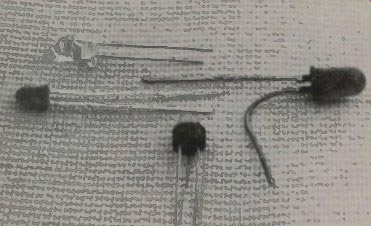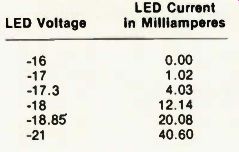
By Carl Babcoke, Editor
(AP Our electronics industry has its share of technical myths and half truths, and several have been circulated about LEDs. Most of the wrong impressions can be eliminated by correct answers to these questions. Do all LEDs have the same voltage rating? (The impression sometimes has been given that all LEDs should be operated at 1.6 volts DC.) Is the forward resistance of LEDs different from the reverse resistance? How does the front-to-back ratio compare to ordinary silicon power-supply diodes? Can LEDs be operated also from AC? Does an LED light at all from reverse current? Can LEDs be damaged easily by reverse voltage? What is the best way of testing LEDs? These questions are not often answered; therefore, I decided to test some typical LEDs under controlled conditions, and thus learn the answers.
Connecting LEDs for Tests
The assortment of 15 LEDs I obtained had four different types. Also, I bought a single higher priced LED for comparison purposes. Several of the LEDs are shown in the picture.
Each LED in turn was connected to the adjustable supply voltage through a current-limiting resistor. The color coding of the resistor indicated 330 ohms, but it measured 350 ohms. One digital volt meter was connected to monitor the LED current, and another DMM was used to measure the supply voltage and the LED voltage, as shown in the schematic.
To make the with the needs probes, I kept the +5 volts, for most tests compatible of digital-logic supply at about of the tests.
Testing Voltage and Current
First, one LED was tested for DC voltage and current, the readings were written down, and the hue and brightness of the light were noted. For the second test, the LED was reversed in polarity, and the reverse current was measured and written on the data table. At -6 volts (the supply voltage without any load), most LEDs showed no measurable leakage (0.00 mills on the 20 milliampere range). All 16 LEDs were checked, and the readings recorded.
Range of Measured LED Voltages
These LEDs showed a surprising range of voltages. One type had about 3.5 volts at about 4 milli amperes, another kind measured about 3.1 volts at 9.5 mills, and others of larger sizes checked about 1.70 volts at 9.5 mills. In addition, the catalog of one prominent manufacturer shows LEDs with these specs: 2.2 volts at 10 mills; 2.4 volts at 20 mills; and 1.6 volts at 20 milliamperes. Also, I have measured several 7-segment displays that operated from about 1.6 volts.
Therefore, we can say that MOST LEDs should be operated between +1.6 and +1.7 volts; however, some types require up to twice that voltage.
Resistance Tests
The forward and reverse resistances of the 16 LEDs were checked easily with an ohmmeter, and the tests identified the anodes and cathodes.
On the 1K range of a VTVM, the majority of the LEDs showed a forward resistance between 90K and 150K (although one type required a change to the 1M range, where the reading was 80M). Most of the reverse-bias resistances were infinitely high (open), however one LED tested only 15M.
---

------------
TABLE A
LED Reverse Current
(The same circuit, but with the LED polarity reversed)

---------
When tested on the same 1K range of the VTVM, power-supply silicon diodes measured around 5K. So, LEDs have much higher resistances than do ordinary power supply diodes, and have higher voltage drops.
Reverse Breakdown Voltage
Next, I attempted to destroy one of the +3.11-voltage LEDs by applying excessive reverse-bias voltage.
In the catalogs, many LEDs are listed as having reverse breakdown voltages between 3 volts and 10 volts. These figures imply that LEDs can't withstand much reverse voltage without damage or excessive current.
The reversed-polarity LED was connected to the variable-voltage supply through the same 350-ohm resistor, and the meter readout was watched carefully as the reverse voltage was increased slowly. Up to -16 volts, no current was measured.
At 17 volts, the current was slightly above 1 milliampere, and higher voltages increased the current at an exponential rate. Table A gives the results at six values of reversed voltage.
The readings are similar to those obtained by the reverse-biasing of zener diodes. Therefore, it seems appropriate to say that LEDs can exhibit a zener effect, when heavily reverse-biased.
Incidentally, the LED did not short out, and it glowed normally when forward voltage was applied later.
AC Operation?
From the results of the resistance and reverse-voltage tests, it seems clear that most modern LEDs can be used safely with low AC voltages, and will have normal diode action (although with higher voltage drop). For additional dependability, a fast-switching silicon diode could be connected in parallel with the LED, but with the polarity reversed.
Regulation Effect
When a current-limiting resistor is connected in series with an LED, the diode effect tends to regulate or stabilize the DC voltage across the LED. To illustrate this action, the most-expensive of the 16 LEDs was tested in the circuit with seven different supply voltages, as shown in Table B. Which voltage is correct for that LED?
Power-supply diodes have the same kind of regulation when operated in similar circuits with DC power. However, the center of the regulation is around 0.9 to 1.0 volt.

-------- TABLE B LED Voltage Versus Current
A 20.4% increase of voltage produced a 1725% increase of current.
----------
Answers and Comments
Here are answers to some questions asked at the beginning:
• LEDs are available in many different voltage and current ratings. Probably, the most popular is the 1.6-volt rating. However, I have not yet found one that drew even a fraction of the 20 milliamperes that seems to be a standard for many types. I would advise you to test LEDs as shown here before you include one in a circuit, especially if the ratings are not shown;
• LEDs can be checked by measuring the forward and reverse resistances. However, the readings are much higher than those for conventional diodes, and such tests are not very informative, except for identifying the anode and cathode.
• Yes, LEDs can be operated from AC power, provided the reverse voltage is below the reverse-voltage rating of the LED. Otherwise, an additional conventional diode must be added for protection;
• LEDs produce no light from reverse current. Neither will they light when tested for forward conduction by an ohmmeter; and
• LEDs appear to have a zener action that protects them from damage when the reverse voltage and current is not too excessive.
However, they can't tolerate the high reverse voltages that are normal for power-supply operation.
Although LEDs with current limiting resistors attempt to stabilize the voltage drop across themselves, the current does vary greatly with small changes of voltage. Also, the brightness increases in step (approximately) with the increase of current.
(adapted from: Electronic Servicing magazine, Feb. 1978)
Next:
Prev: